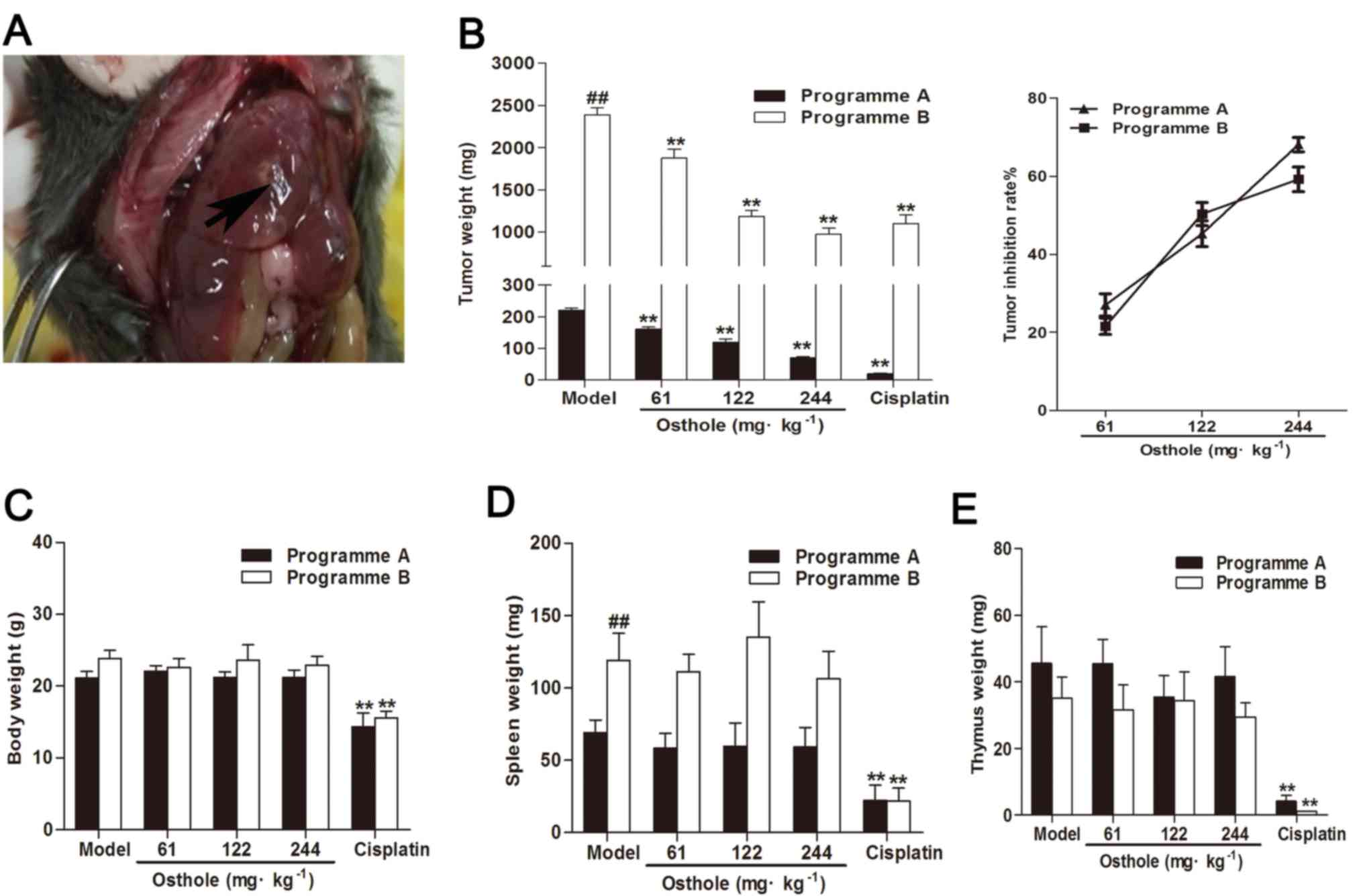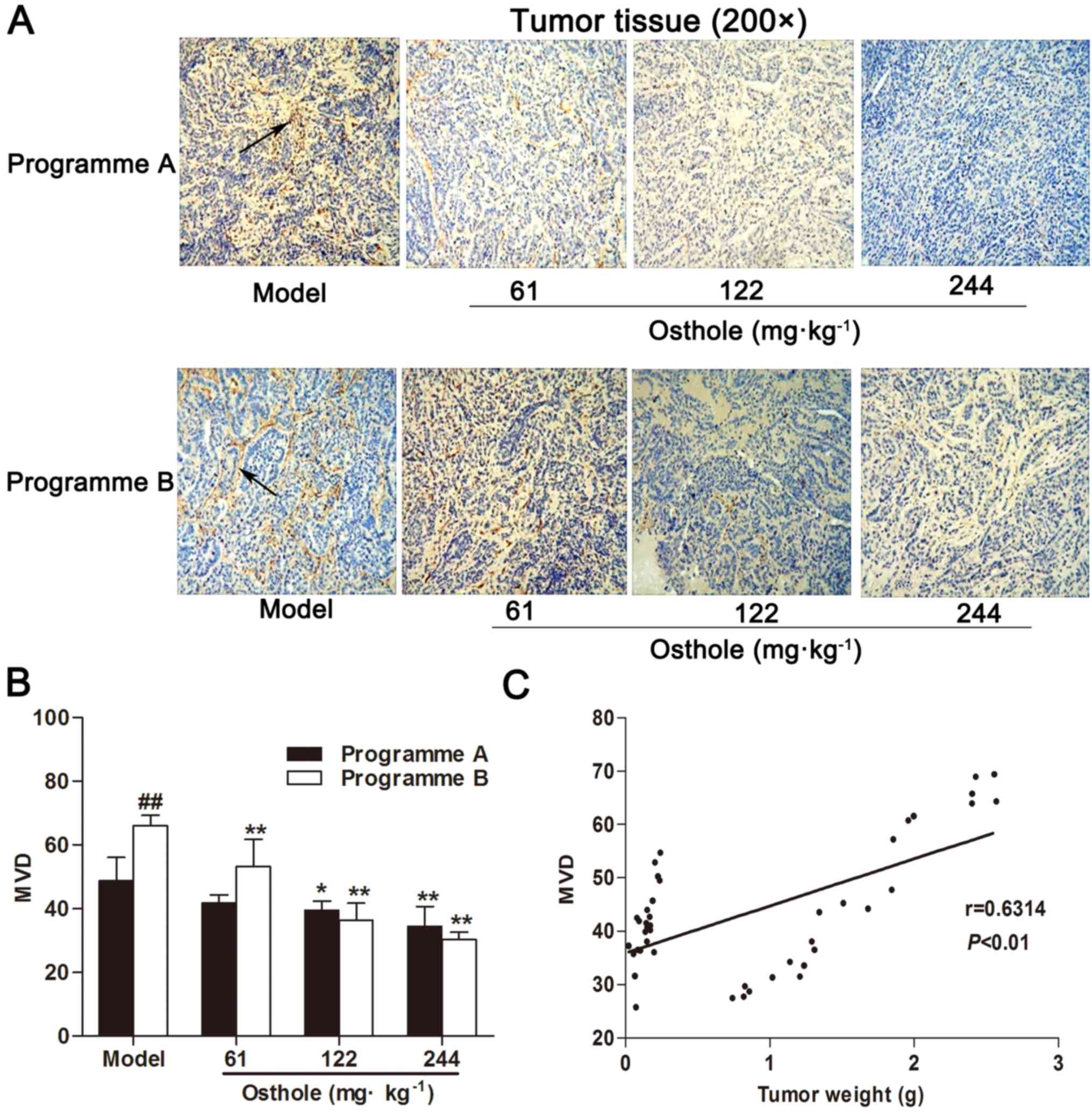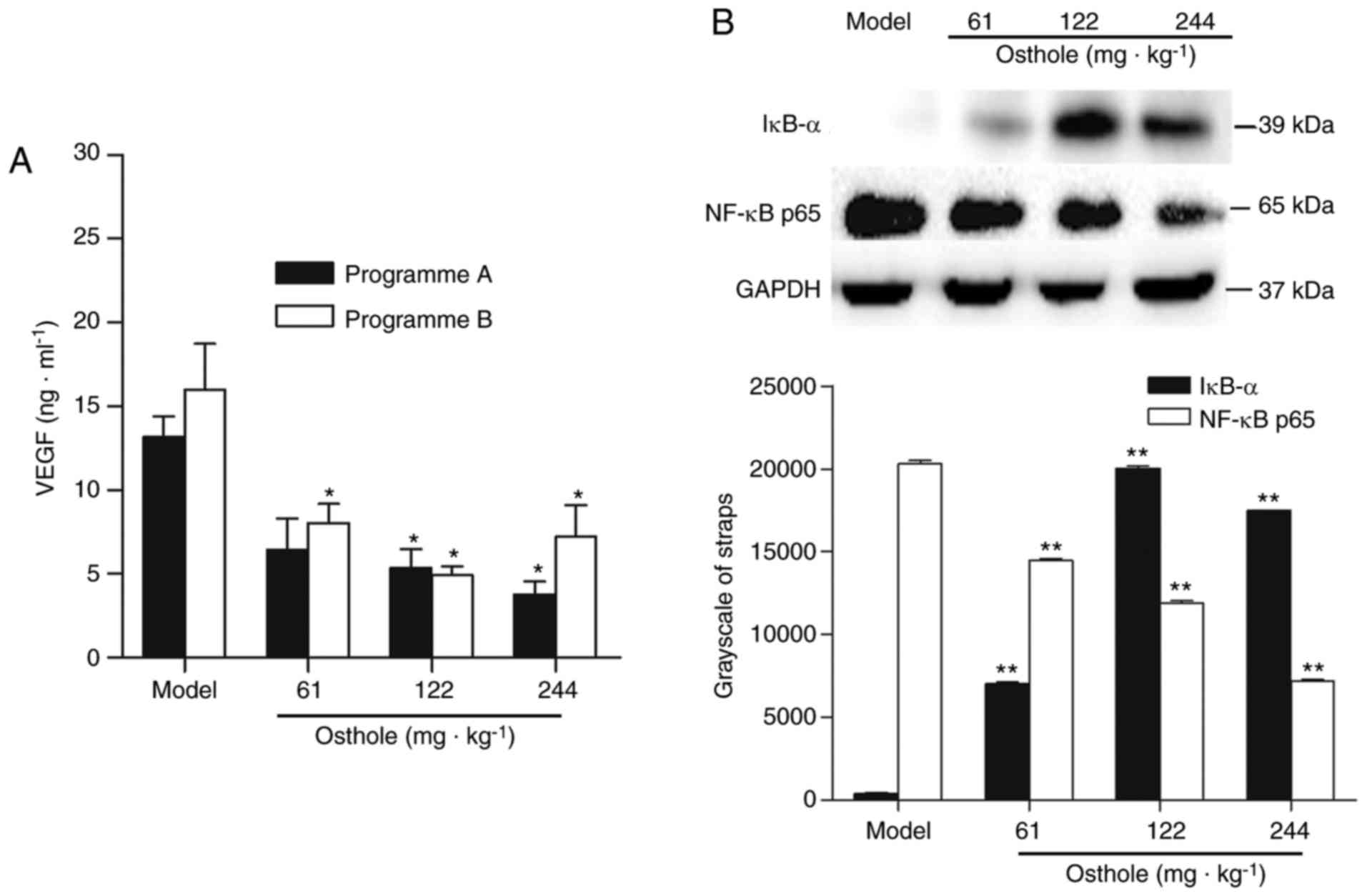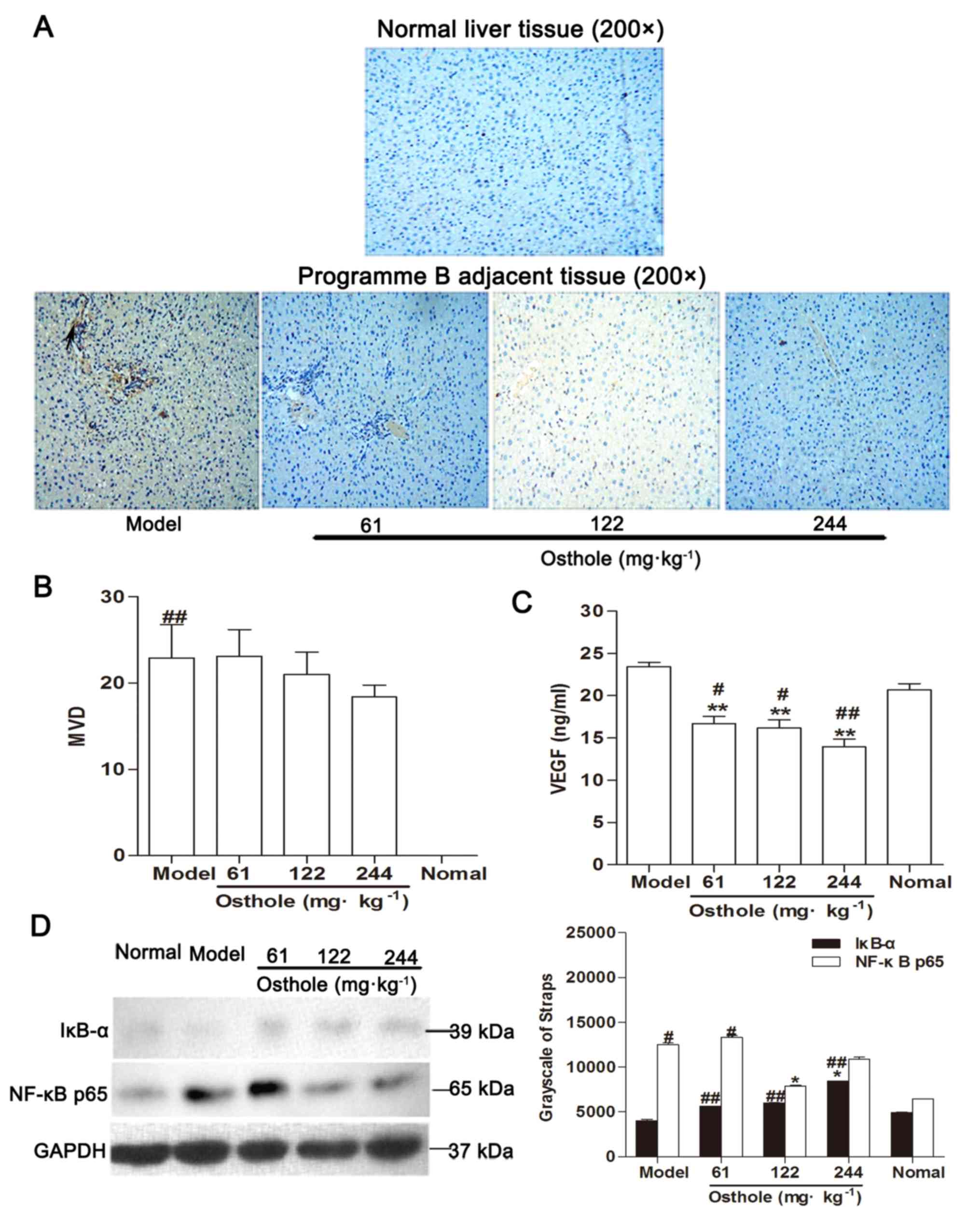|
1
|
Detmar M: Tumor angiogenesis. J Investig
Dermatol Symp Proc. 5:20–23. 2000. View Article : Google Scholar : PubMed/NCBI
|
|
2
|
Yance DR Jr and Sagap SM: Targeting
angiogenesis with integrative cancer therapies. Integr Cancer Ther.
5:9–29. 2006. View Article : Google Scholar : PubMed/NCBI
|
|
3
|
Zhao Y and Adjei AA: Targeting
angiogenesis in cancer therapy: Moving beyond vascular endothelial
growth factor. Oncologist. 20:660–673. 2015. View Article : Google Scholar : PubMed/NCBI
|
|
4
|
Yu HB, Zhang HF, Zhang X, Li DY, Xue HZ,
Pan CE and Zhao SH: Resveratrol inhibits VEGF expression of human
hepatocellular carcinoma cells through a NF-kappa B-mediated
mechanism. Hepatogastroenterology. 57:1241–1246. 2010.PubMed/NCBI
|
|
5
|
Rajabi M and Mousa SA: The role of
angiogenesis in cancer treatment. Biomedicines. 5:E342017.
View Article : Google Scholar : PubMed/NCBI
|
|
6
|
Berqers G and Hanahan D: Modes of
resistance to anti-angiogenic therapy. Nat Rev Cancer. 8:592–603.
2008. View
Article : Google Scholar : PubMed/NCBI
|
|
7
|
Li C, Liu T, Bazhin AV and Yang Y: The
sabotaging role of myeloid cells in anti-angiogenic therapy:
Coordination of angiogenesis and immune suppression by hypoxia. J
Cell Physiol. 232:2312–2322. 2017. View Article : Google Scholar : PubMed/NCBI
|
|
8
|
Hillen F and Griffioen AW: Tumour
vascularization sprouting angiogenesis and beyond. Cancer
Metastasis Rev. 26:489–502. 2007. View Article : Google Scholar : PubMed/NCBI
|
|
9
|
Chouaib S, Messai Y, Couve S, Escudier B,
Hasmim M and Noman MZ: Hypoxia promotes tumor growth in linking
angiogenesis to immune escape. Front Immunol. 3:212012. View Article : Google Scholar : PubMed/NCBI
|
|
10
|
McDonald PC, Chafe SC and Dedhar S:
Overcoming hypoxia-mediated tumor progression: Combinatorial
approaches targeting ph regulation, angiogenesis and immune
dysfunction. Front Cell Dev Biol. 4:272016. View Article : Google Scholar : PubMed/NCBI
|
|
11
|
Li Y and Martin RC II: Herbal medicine and
hepatocellular carcinoma: Applications and challenges. Evid Based
Complement Alternat Med. 2011:5412092011. View Article : Google Scholar : PubMed/NCBI
|
|
12
|
Yang LL, Wang MC, Chen LG and Wang CC:
Cytotoxic activity of coumarins from the fruits of Cnidium
monnieri on leukemia cell lines. Planta Med. 69:1091–1095.
2003. View Article : Google Scholar : PubMed/NCBI
|
|
13
|
Riviere C, Goossens L, Pommery N, Fourneau
C, Delelis A and Henichart JP: Antiproliferative effects of
isopentenylated coumarins isolated from phellolophium
madagascariense baker. Nat Prod Res. 20:909–916. 2006. View Article : Google Scholar : PubMed/NCBI
|
|
14
|
Xu X, Zhang Y, Qu D, Jiang T and Li S:
Osthole induces G2/M arrest and apoptosis in lung cancer A549 cells
by modulating PI3K/Akt pathway. J ExpClin Cancer Res. 30:33–39.
2011. View Article : Google Scholar
|
|
15
|
Chou SY, Hsu CS, Wang KT, Wang MC and Wang
CC: Antitumor effects of osthole from Cnidium monnieri: An
in vitro and in vivo study. Phytother Res. 21:226–230. 2007.
View Article : Google Scholar : PubMed/NCBI
|
|
16
|
Zhang L, Jiang G, Yao F, He Y, Liang G,
Zhang Y, Hu B, Wu Y, Li Y and Liu H: Growth inhibition and
apoptosis induced by osthole, a natural coumarin, in hepatocellular
carcinoma. PLoS One. 7:e378652012. View Article : Google Scholar : PubMed/NCBI
|
|
17
|
Zhang L, Jiang G, Yao F, Liang G, Wang F,
Xu H, Wu Y, Yu X and Liu H: Osthole promotes anti-tumor immune
responses in tumor-bearing mice with hepatocellular carcinoma.
Immunopharmacol Immunotoxicol. 37:301–307. 2015. View Article : Google Scholar : PubMed/NCBI
|
|
18
|
Potente M, Gerhardt H and Carmeliet P:
Basic and therapeutic aspects of angiogenesis. Cell. 146:873–887.
2011. View Article : Google Scholar : PubMed/NCBI
|
|
19
|
Turlin B, Le Quilleuc D, Leroyer P,
Brissot P, Deugnier Y and Loréal O: High vascular endothelial
growth factor(VEGF) expression in chemically-induced hepatic
microcancers in mice. J Hepatol. 37:620–624. 2002. View Article : Google Scholar : PubMed/NCBI
|
|
20
|
Tong Q, Zheng L, Lin L, Li B, Wang D,
Huang C and Li D: VEGF is upregulated by hypoxia-induced mitogenic
factor via the PI-3K/Akt-NF-kappaB signaling pathway. Respir Res.
7:372006. View Article : Google Scholar : PubMed/NCBI
|
|
21
|
Zhang Q, Lu Y, Proulx ST, Guo R, Yao Z,
Schwarz EM, Boyce BF and Xing L: Increased lymphangiogenesis in
joints of mice with inflammatory arthritis. Arthritis Res Ther.
9:R1182007. View
Article : Google Scholar : PubMed/NCBI
|
|
22
|
Kwon OJ, Kim PH, Huyn S, Wu L, Kim M and
Yun CO: A hypoxia- and {alpha}-fetoprotein-dependent oncolytic
adenovirus exhibits specific killing of hepatocellular carcinomas.
Clin Cancer Res. 16:6071–6082. 2010. View Article : Google Scholar : PubMed/NCBI
|
|
23
|
Wei D, Li Q, Wang XL, Wang Y, Xu J, Feng
F, Nan G, Wang B, Li C, Guo T, et al: Oncolytic Newcastle disease
virus expressing chimeric antibody enhanced anti-tumor efficacy in
orthotopic hepatoma-bearing mice. J ExpClin Cancer Res.
34:1532015.
|
|
24
|
McFadden DG, Vernon A, Santiago PM,
Martinez-McFaline R, Bhutkar A, Crowley DM, McMahon M, Sadow PM and
Jacks T: p53 constrains progression to anaplastic thyroid carcinoma
in a Braf-mutant mouse model of papillary thyroid cancer. Proc Natl
Acad Sci U S A. 111:E1600–E1609. 2014. View Article : Google Scholar : PubMed/NCBI
|
|
25
|
Meng J, Liu Y, Han J, Tan Q, Chen S, Qiao
K, Zhou H, Sun T and Yang C: Hsp90β promoted endothelial
cell-dependent tumor angiogenesis in hepatocellular carcinoma. Mol
Cancer. 16:722017. View Article : Google Scholar : PubMed/NCBI
|
|
26
|
Kim HY, Kim J, Thi Ha HT, Bang OS, Lee WS
and Hong S: Evaluation of anti-tumorigenic activity of BP3B against
colon cancer with patient-derived tumor xenograft model. BMC
Complement Altern Med. 16:4732016. View Article : Google Scholar : PubMed/NCBI
|
|
27
|
Chen H, Zhang J, Luo J, Lai F, Wang Z,
Tong H, Lu D, Bu H, Zhang R and Lin S: Antiangiogenic effects of
oxymatrine on pancreatic cancer by inhibition of the NF-κB-mediated
VEGF signaling pathway. Oncol Rep. 30:589–595. 2013. View Article : Google Scholar : PubMed/NCBI
|
|
28
|
Hui L and Chen Y: Tumor microenvironment:
Sanctuary of the devil. Cancer Lett. 368:7–13. 2015. View Article : Google Scholar : PubMed/NCBI
|
|
29
|
Ribatti D and Vacca A: The role of
microenvironment in tumor angiogenesis. Genes Nutr. 3:29–34. 2008.
View Article : Google Scholar : PubMed/NCBI
|
|
30
|
Leenders MW, Nijkamp MW and Rinkes Borel
IH: Mouse models in liver cancer research: A review of current
literature. World J Gastroenterol. 14:6915–6923. 2008. View Article : Google Scholar : PubMed/NCBI
|
|
31
|
Rao Q, You A, Guo Z, Zuo B, Gao X, Zhang
T, Du Z, Wu C and Yin H: Intrahepatic tissue implantation
represents a favorable approach for establishing orthotopic
transplantation hepatocellular carcinoma mouse models. PLoS One.
11:e01482632016. View Article : Google Scholar : PubMed/NCBI
|
|
32
|
Li B, Zhang Y, Wu W, Du G, Cai L, Shi H
and Chen S: Neovascularization of hepatocellular carcinoma in a
nude mouse orthotopic liver cancer model: A morphological study
using X-ray in-line phase-contrast imaging. BMC Cancer. 17:732017.
View Article : Google Scholar : PubMed/NCBI
|
|
33
|
Woodfield SE, Shi Y, Patel RH, Jin J,
Major A, Sarabia SF, Starosolski Z, Zorman B, Gupta SS, Chen Z, et
al: A novel cell line based orthotopic xenograft mouse model that
recapitulates human hepatoblastoma. Sci Rep. 7:177512017.
View Article : Google Scholar : PubMed/NCBI
|
|
34
|
Weidner N, Semple JP, Welch WR and Folkman
J: Tumor angiogenesis and metastasis - correlation in invasive
breast carcinoma. N Engl J Med. 324:1–8. 1991. View Article : Google Scholar : PubMed/NCBI
|
|
35
|
El-Assal ON, Yamanoi A, Soda Y, Yamaguchi
M, Igarashi M, Yamamoto A, Nabika T and Nagasue N: Clinical
significance of microvessel density and vascular endothelial growth
factor expression in hepatocellular carcinoma and surrounding
liver: Possible involvement of vascular endothelial growth factor
in the angiogenesis of cirrhotic liver. Hepatology. 27:1554–1562.
1998. View Article : Google Scholar : PubMed/NCBI
|
|
36
|
Dai L, Peng XX, Tan EM and Zhang JY:
Tumor-associated antigen CAPERα and microvessel density in
hepatocellular carcinoma. Oncotarget. 7:16985–16995. 2016.
View Article : Google Scholar : PubMed/NCBI
|
|
37
|
Cao Y and Langer R: A review of Judah
Folkman's remarkable achievements in biomedicine. Proc Natl Acad
Sci USA. 105:13203–13205. 2008. View Article : Google Scholar : PubMed/NCBI
|
|
38
|
Aggarwal BB, Vijayalekshmi RV and Sung B:
Targeting inflammatory pathways for prevention and therapy of
cancer: Short-term friend, long-term foe. Clin Cancer Res.
15:425–430. 2009. View Article : Google Scholar : PubMed/NCBI
|
|
39
|
Schmidt D, Textor B, Pein OT, Licht AH,
Andrecht S, Sator-Schmitt M, Fusenig NE, Angel P and
Schorpp-Kistner M: Critical role for NF-kappaB-induced JunB in VEGF
regulation and tumor angiogenesis. EMBO J. 26:710–719. 2007.
View Article : Google Scholar : PubMed/NCBI
|
|
40
|
Ismail HA, Lessard L, Mes-Masson AM and
Saad F: Expression of NF-kappaB in prostate cancer lymph node
metastases. Prostate. 58:308–313. 2004. View Article : Google Scholar : PubMed/NCBI
|
|
41
|
Ghosh S and Karin M: Missing pieces in the
NF-kappaB puzzle. Cell. 109 Suppl:S81–S96. 2002. View Article : Google Scholar : PubMed/NCBI
|
|
42
|
Javan H, Szucsik AM, Li L, Schaaf CL,
Salama ME and Selzman CH: Cardiomyocyte p65 nuclear factor-κB is
necessary for compensatory adaptation to pressure overload. Circ
Heart Fail. 8:109–118. 2015. View Article : Google Scholar : PubMed/NCBI
|
|
43
|
Zhang B, Wang D, Ji TF, Shi L and Yu JL:
Overexpression of lncRNA ANRIL up-regulates VEGF expression and
promotes angiogenesis of diabetes mellitus combined with cerebral
infarction by activating NF-κB signaling pathway in a rat model.
Oncotarget. 8:17347–17359. 2017.PubMed/NCBI
|
|
44
|
Xiong HQ, Abbruzzese JL, Lin E, Wang L,
Zheng L and Xie K: NF-kappaB activity blockade impairs the
angiogenic potential of human pancreatic cancer cells. Int J
Cancer. 108:181–188. 2004. View Article : Google Scholar : PubMed/NCBI
|
|
45
|
Yu C, Li P, Qi D, Wang L, Qu HL, Zhang YJ,
Wang XK and Fan HY: Osthole protects sepsis-induced acute kidney
injury via down-regulating NF-κB signal pathway. Oncotarget.
8:4796–4813. 2017.PubMed/NCBI
|
|
46
|
Li YQ, Wang JY, Qian ZQ, Li YL, Li WN, Gao
Y and Yang DL: Osthole inhibits intimal hyperplasia by regulating
the NF-κB and TGF-β1/Smad2 signalling pathways in the rat carotid
artery after balloon injury. Eur J Pharmacol. 811:232–239. 2017.
View Article : Google Scholar : PubMed/NCBI
|


















